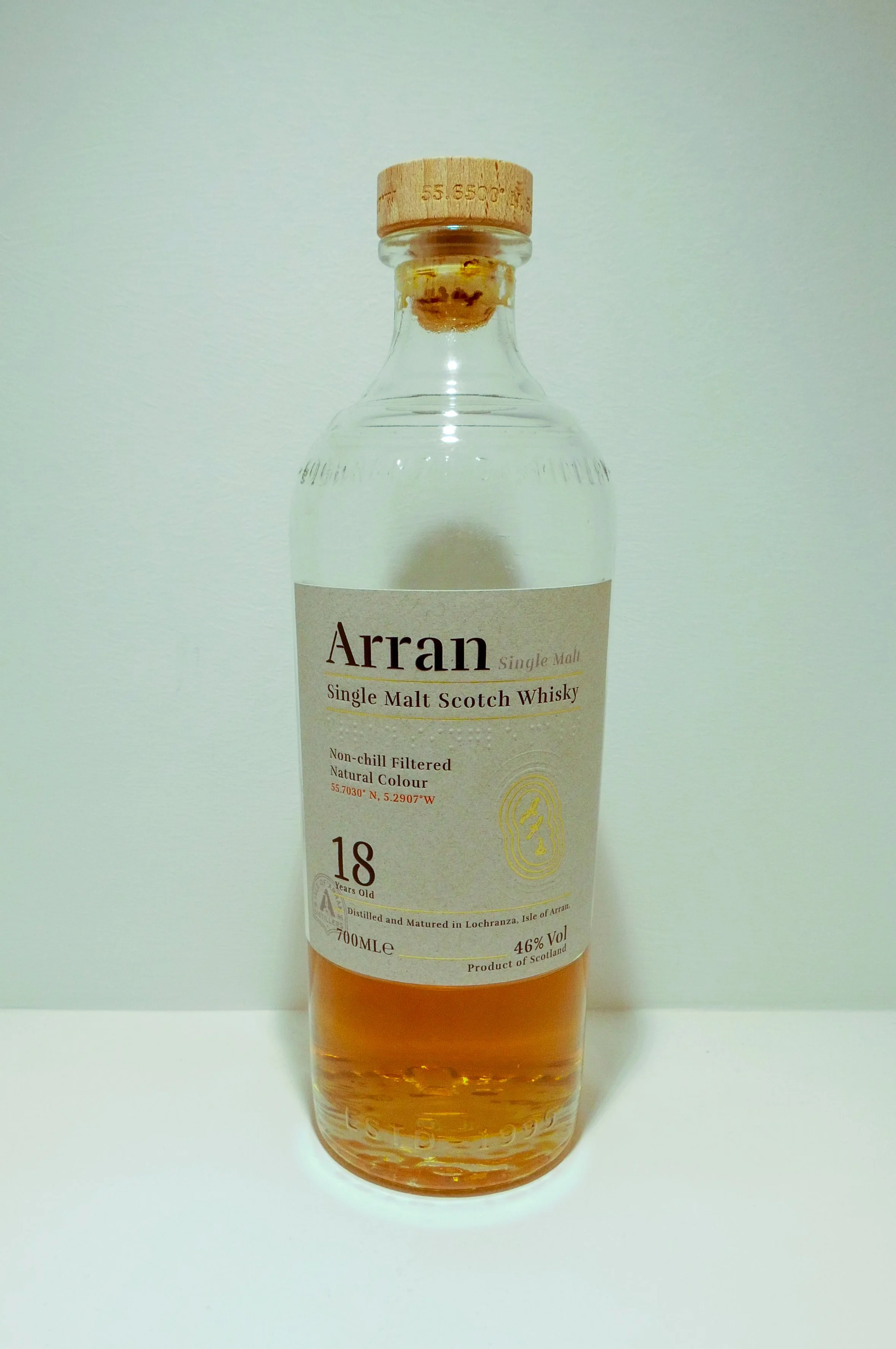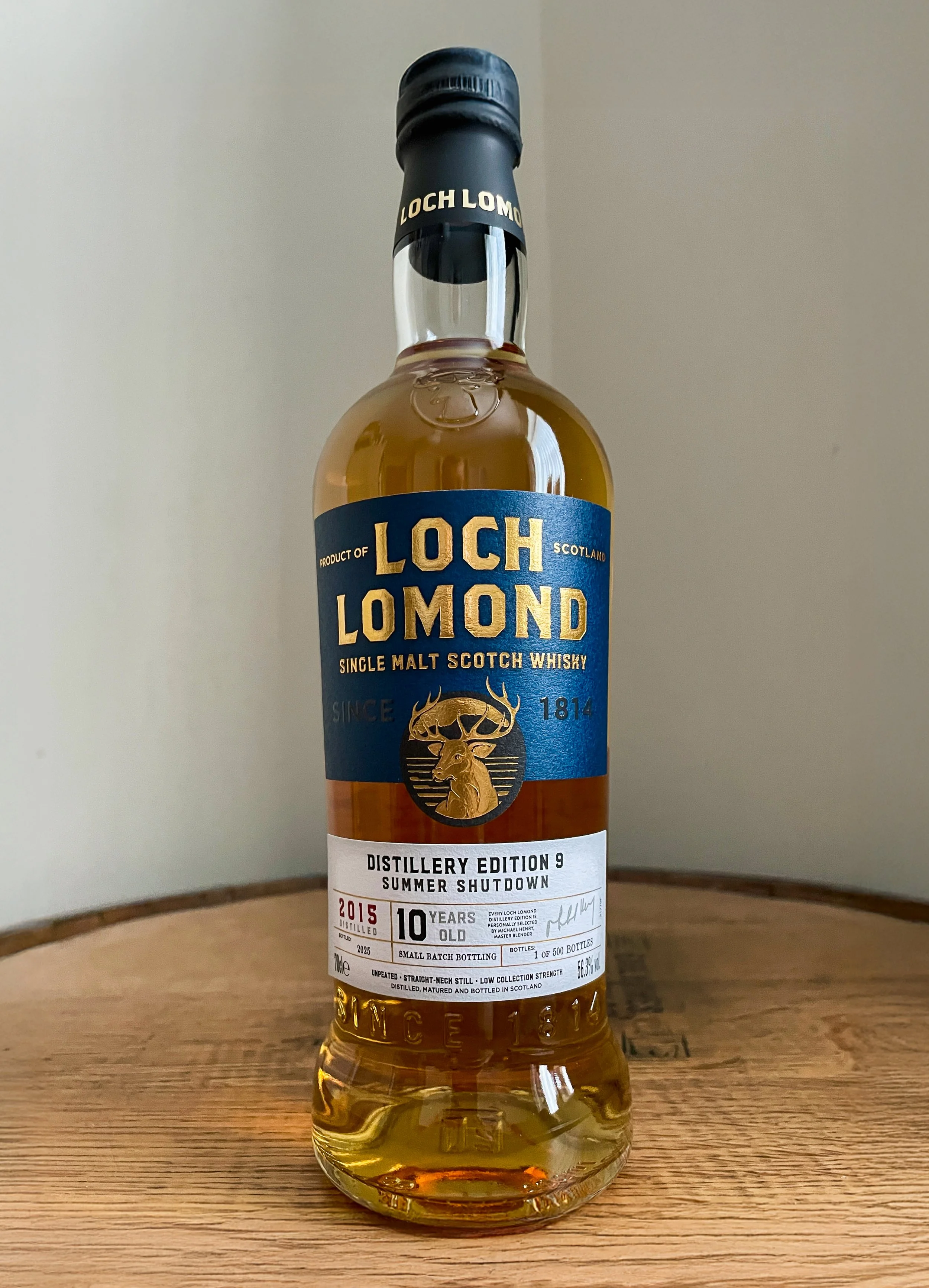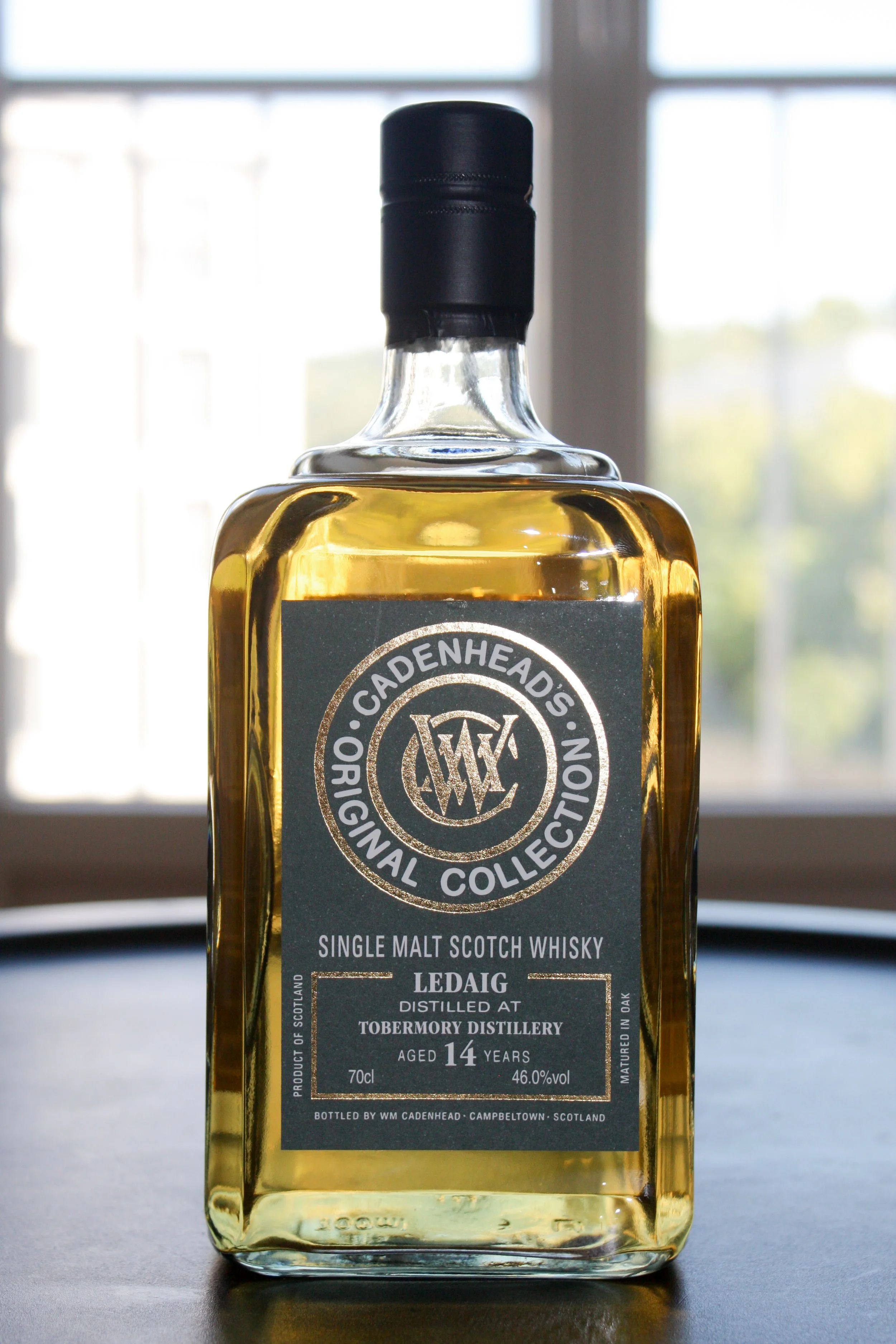Jura 8yo Hepburn’s Choice
One of 303 Bottles | 46% ABV
Score: 5/10
Average.
TL;DR
Fairly average, but I’ll take it over most of the core range
We need to talk about Jura
In a recent review of Compass Box’s Orchard House , I touched upon how, in the summer months, I tend to reach for lighter, zestier drams, as opposed to the decadent, sherry-forward whiskies that call to me in the colder weather. I suspect that this is something that applies to many of us.
After all, it makes sense – just as we tend to eat lighter food in the summer, as opposed to the heavy, carb rich meals that we often crave in winter, when the sun comes out and the days grow longer, we naturally gravitate towards the fruiter, more vibrant end of the whisky spectrum.
Today’s review is going to follow a similar theme, as the whisky I want to talk about is another bourbon-matured, fruit forward, light(ish) whisky…but that’s where the similarities stop.
Unlike Orchard House, this one’s a single malt, as opposed to a blended malt. It’s also from a distillery that isn’t particularly popular – at least, not among enthusiasts.
In fact, I’ll go one further. The whisky I’m going to talk about here is from that most maligned of all Scotch whisky distilleries – a distillery that, when mentioned among fellow whisky botherers, often elicits an apathetic sigh and a weary rolling of the eyes.
Let’s face it, there are quite a few distilleries that currently fall into that category, although this one is particularly reviled.
I’m talking, of course, about Jura.
If you’re a regular Dramface reader, then you may have already made your mind up about Jura. The flagbearer for poorly presented, pedestrian, price-point single malt, it’s a whisky that you walk past on your way to the pet food aisle in Sainsburys, to buy your cat litter, without so much as a glance. Even when it’s on offer for less than £25 – which it regularly is – it still doesn’t pique your interest. Flat, anodyne and utterly uninspiring, it’s the single malt equivalent of elevator music. Right?
Well, maybe. Sort of. Sometimes, it’s not that simple, though. Because, if you’re anything like me, then perhaps you’re not as inclined to hate Jura as much as you might. Okay, so they prioritise volume and price over quality, but even so, speaking personally, there was once a time when I used to regularly buy their expressions. Don’t get me wrong, it’s been well over a decade since an official bottle of Jura has made it onto my whisky shelf, but that wasn’t always the case.
Back when I first began to explore whisky, Jura was a regular staple in my collection. In fact, it was probably the whisky that I bought more than any other. Back then, the core range looked a little different. There was the Elixir, the Superstition, the Origin, and a couple of others. I forget their names. Because they were easily forgettable. They were all affordable, though. And, at the time, that was all that mattered to me.
Because back then, whisky was new to me, and all I really wanted was something to pour into a tumbler, as I tried to develop my nascent palate. I had an inkling that whisky might be something I could enjoy, if I gave it a chance, but I wasn’t prepared to spend a lot of money on it. Lack of chill filtration wasn’t something that I looked for, and I’d never heard of E150a. Jura – along with Monkey Shoulder and Glenfiddich 12 – allowed me to dip my toe into the world of whisky, without breaking the bank. As such, it opened that first door. For that reason, I’m reluctant to disparage it.
Despite everything I’ve said then, this isn’t a rant. I could rant about Jura, as I do share the frustration that many enthusiasts feel, but I’ll leave that for another time. I’ll just say that it’s one of those distilleries that I quickly outgrew. A bit like a student musician who’s given a £50 starter instrument, a year or two into my whisky journey, I began to realise that if I was going to get any further, I needed to up my budget and leave the likes of Jura behind. Since then, it’s pretty much fallen off my radar entirely. Or rather, it had. Until recently.
I say that because, from time to time, it’s nice to revisit some of these distilleries, and a few weeks ago, I did just that. I was at a friend’s 40th, and the venue that they’d hired had two whiskies behind the bar. One was a bottle of Bells, and the other was a bottle of Jura 10yo. Towards the end of the evening, after drinking a few beers, I decided I wanted to try the Jura 10.
It would be unfair of me to sit here and critique the 10yo. I had one dram of it, in a bar, in a plastic tumbler, whilst socialising with friends, so even if it had been an absolutely stellar whisky, it’s unlikely that in that context it would have shined. All I’ll say is that it tasted like whisky, and that, whilst it was perfectly acceptable in the moment, it didn’t make me want to rush out and buy a bottle. It was, however, enough to pique my curiosity, and the next day, I decided to Google ‘independently bottled Jura.’
I’ll be honest, I wasn’t expecting to find anything. As far as I was aware, Jura wasn’t a distillery that featured among the indy bottlers. I don’t remember there being any around back in the days when I used to regularly buy Jura, although to be fair, back then, I probably wasn’t looking for indy bottles, so perhaps I just missed them.
Either way, it turns out that naturally presented Jura does exist in indy guise. Whilst it isn’t as abundant as say, Caol Ila, or Benrinnes, there does seem to be a fair bit of it about.
The bottle that I ended up buying is from Hunter Laing and is part of their Hepburn’s Choice range. It cost me £53, which for an 8yo Jura feels expensive, when you consider that you can sometimes pick up their 14yo Rye Cask for close to £30 on offer.
Still, I decided to take a punt on it anyway. At 46% and with the words ‘never chill-filtered’ and ‘never coloured’ written on the bottle, it ticked all the boxes. I was keen to see what naturally presented Jura, at a decent ABV, tastes like – and whether or not it has a bit more going for it than the unfathomably cheap, price-point expressions that I’ve spent the last decade or two walking past in the supermarket.
Review
Jura 8yo, Hepburn’s Choice, Distilled in 2014, Bottled in 2023, Bottled from a single refill barrel, 303 bottles, 46% ABV
£53 - Available Online
I began this review by describing this expression as a light(ish) whisky. I added the ‘ish’ for a reason.
The reason is that when I first cracked this open, I felt that it was a very fruit forward, fairly zesty, light summery whisky, akin to the aforementioned Orchard House, or perhaps even Glencadam’s 10yo. I didn’t really pick up on any richness or weight.
Then, about five or six drams in, I decided to pour it alongside a glass of Orchard House…and man, did I end up reassessing this whisky. We often talk about drinking contrasting whiskies together, but sometimes drinking two whiskies that are broadly similar can be a real eye-opener. It highlights their differences. Sometimes, those differences are starker than you might think.
In the case of this Jura, drinking it alongside Orchard House made me realise that, whilst it is a light whisky, there’s a weight and a richness to it that I’d initially overlooked. Since that evening, I’ve been able to taste notes here that I hadn’t picked up on before. It was an education, and as such, I went back to my tasting notes and reassessed a lot of my initial impressions.
Score: 5/10
Average.
TL;DR
Fairly average, but I’ll take it over most of the core range
Nose
The first thing I get on the nose is vanilla. Think ice-cream soda. There’s a touch of orange here too, some liquorice toffee, some ginger and some more vanilla – this time in the form of a vanilla custard type note. I also get star anise and some crisp, white wine. It’s light, but there’s an underlying richness to it as well, that the vanilla helps to emphasise.
Palate
If there’s such a thing as a vanilla bomb, then this is probably it. I noticed the vanilla as soon as I tasted this whisky, but it wasn’t until I drank it alongside the Orchard House that the vanilla note became really prominent. It’s a rich, creamy vanilla, like vanilla toffee, vanilla custard, or crème brulee. Although there are some lighter, fruitier notes here, it does dominate them.
That said, if you dig around, there is more to it. It’s herbaceous, for a start. I get more of that liquorice that I picked up on the nose, only this time, it comes through more as a liquorice root sort of note. I also get some rosemary, some star anise and a touch of orange. There’s some bitter camomile here as well, and a little bit of light coffee.
It's certainly not a complex whisky, but if you fancy drinking something that doesn’t demand immediate analysis then this will do the job nicely. The herbaceous notes add a dimension to it that keeps it engaging, and it feels like a very honest whisky. This might sound strange, but it reminds me of how whisky used to taste, before I started really getting into it. It’s just whisky. Simple, straightforward, matured in an ex-bourbon barrel, straight to the point whisky.
The Dregs
I like it. It’s not going to set anybody’s world on fire, but it’s naturally presented, engaging enough to keep me pouring it, and it’s from a distillery that I typically associate with banal, price-point ubiquity. On that basis, I’m satisfied with the price that I paid for it, even if I’m not in any hurry to replace it.
The score that I’m giving it reflects that. It might seem a little on the low side, but consider that most of Jura’s core range offerings don’t even warrant a second glance, and 5/10 isn’t too bad. I think if there was just a little less vanilla, and a little more in the way of those herbaceous notes, I’d probably score it a 6, as I was on the fence with this one. The vanilla note is a little cloying though. It’s certainly not a bad whisky, but it also sits comfortably in the middle of the pack.
I said I wouldn’t rant about Jura, and I don’t intend to, but I do want to get something off my chest. As I’ve already said, I don’t hate Jura, and I’m sure that the people who work there genuinely care about the product. I’m also fairly certain that Jura, when it’s disgorged from the cask, can be great whisky, even if this particular expression falls a little short. It’s what happens to it when they bottle it that often ruins the stuff.
I also completely understand the need for price-point, entry level single malts that can be enjoyed by beginners and casual drinkers. As far as I’m concerned, enjoying a Jura 10yo over ice is every bit as valid as enjoying a dram of £2000 Brora. I’m not a whisky snob. If you’re engaging with whisky – whatever whisky it is – then that can only be a good thing.
What I do wish though, is that Jura would give us whisky enthusiasts something – anything – to get excited about. In writing this review, I decided to do some research, and the only Jura expression that I could find in their ‘Signature Series’ that was bottled at a decent ABV, was the 21yo Tide.
At 46.7% it might be tempting, but it means spending £150 to try something from a distillery whose core range is otherwise completely uninspiring. Admittedly, £150 for a 21yo whisky is a fair price in today’s market, but if we can’t engage with anything less expensive in order to convince us that Jura is worth our time and money, then are we really going to take a punt on something that high end?
The answer is probably no. Or at least, it’s a no in my case. Jura’s 21yo may well be a fine whisky, but I’m not prepared to part with £150 to find out. Not unless I can taste something decent, at the lower end of the core range.
For now, then, I’ll continue to walk past Jura whenever I’m in the supermarket, and keep an eye on the indy bottlers instead. Jura in its independent guise obviously does turn up from time to time.
This one, whilst not being stellar, is certainly competent. The fact that it’s been bottled at a decent ABV, with no added colour and no chill-filtration, is enough to elevate it above any of the other Jura’s I’ve tasted.
It's just a pity there’s nothing I’ve found in the core range to rival it.
Score: 5/10
Tried this? Share your thoughts in the comments below. FMc
-
Dramface is free.
Its fierce independence and community-focused content is funded by that same community. We don’t do ads, sponsorships or paid-for content. If you like what we do you can support us by becoming a Dramface member for the price of a magazine.
However, if you’ve found a particular article valuable, you also have the option to make a direct donation to the writer, here: buy me a dram - you’d make their day. Thank you.
For more on Dramface and our funding read our about page here.










































